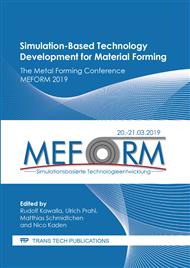p.57
p.66
p.76
p.85
p.93
p.101
p.112
p.119
p.125
Simulation-Based Investigation of the Influence of Process Parameter Deviations on the Quality of Clinch Connections with Preformed Hole
Abstract:
In this work, the influences of deviations of material properties (used material is aluminium for both metal sheets), hole geometry (diameter, chamfer at the bottom and rounding at the top) and offset between punch and hole on the quality of a clinched connection are analysed. The analyses were done with numerical forming simulations, which were validated by experimental tests. For each process parameter, models were built up to simulate the forming process. After simulation of the forming process, it was possible to measure the resulting undercut and to identify the dependency between process parameters and width of undercut. This shows the influence of each investigated parameter on clinch quality and enables to set tolerances as high as possible but small enough to get the required undercut in the clinched connection.
Info:
Periodical:
Pages:
112-118
Citation:
Online since:
March 2019
Authors:
Keywords:
Permissions:
Share:
Citation:


